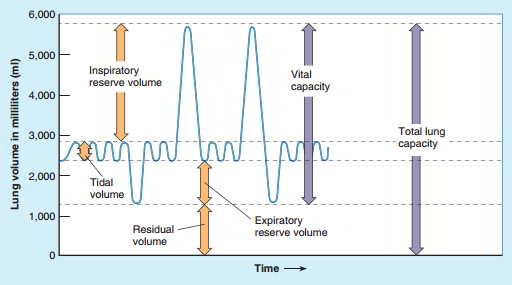Healthy adults average 12 to 15 quiet breathing cycles per minute. A breathing cycle is one inspiration followed by one expiration. The volume of air inhaled and exhaled in a quiet or forceful breathing cycle varies with size, sex, age, and physical condition. The average respiratory volumes have been determined by size, age, and sex in order to enable evaluation of pulmonary functions. Respiratory volumes that are 80% or less than the healthy range usually indicate some form of pulmonary disease.
An instrument called a spirometer is used to determine respiratory volumes. It produces a spirogram, a graphic record of the volume of air exchanged.
The volume of air inhaled or exhaled in a quiet breathing cycle is about 500 ml, and it is known as the tidal volume (TV). Forceful inspirations and expirations can exchange a much greater volume of air. The maximum volume of air that can be forcefully inhaled after a tidal inspiration is about 3,000 ml, and it is known as the inspiratory reserve volume (IRV).
The maximum volume of air that can be forcefully exhaled after a tidal expiration is about 1,100 ml, and it is known as the expiratory reserve volume (ERV). About 1,200 ml of air remains in the lungs after a maximum forced expiration. This residual air is known as the residual volume (RV). Once an infant takes its first breath, there is always residual volume in the lungs. The surfactant in alveoli keeps the alveoli from collapsing. The intrapleural pressure and the surface tension of the pleural fluid keep the lungs partially inflated.
Respiratory capacities can be calculated by summation of two or more respiratory volumes. The maximum amount of air that can be forcefully exchanged is known as the vital capacity (VC), and it is equal to the sum of the tidal volume, the inspiratory reserve volume, and the expiratory reserve volume-about 4,600 ml. The total lung capacity (TLC) is equal to the sum of the vital capacity and the residual volume-about 5,800 ml.
Summary of Respiratory Volumes And Capacities
| Name | Definition | Average Volume |
| Tidal volume (TV) | Volume of air inhaled or exhaled during quiet breathing | 500 ml |
| Inspiratory reserve volume (IRV) | Volume of air that can be forcefully inhaled after a tidal volume inhalation | 3.000 ml |
| Expiratory reserve volume (ERV) | Volume of air that can be forcefully exhaled after a tidal volume expiration | 1.100 ml |
| Vital capacity (VC) | Maximum volume of air that can be forcefully exhaled after a maximum forceful inhalation VC = TV + IRV + ERV | 4,600 ml |
| Residual volume (RV) | Volume of air remaining in the lungs after a maximum forceful exhalation | 1,200 ml |
| Total lung capacity (TLC) | Maximum volume of air that the lungs can contain TLC = VC + RV | 5.800 ml |


 (59 votes, average: 4.73 out of 5)
(59 votes, average: 4.73 out of 5)